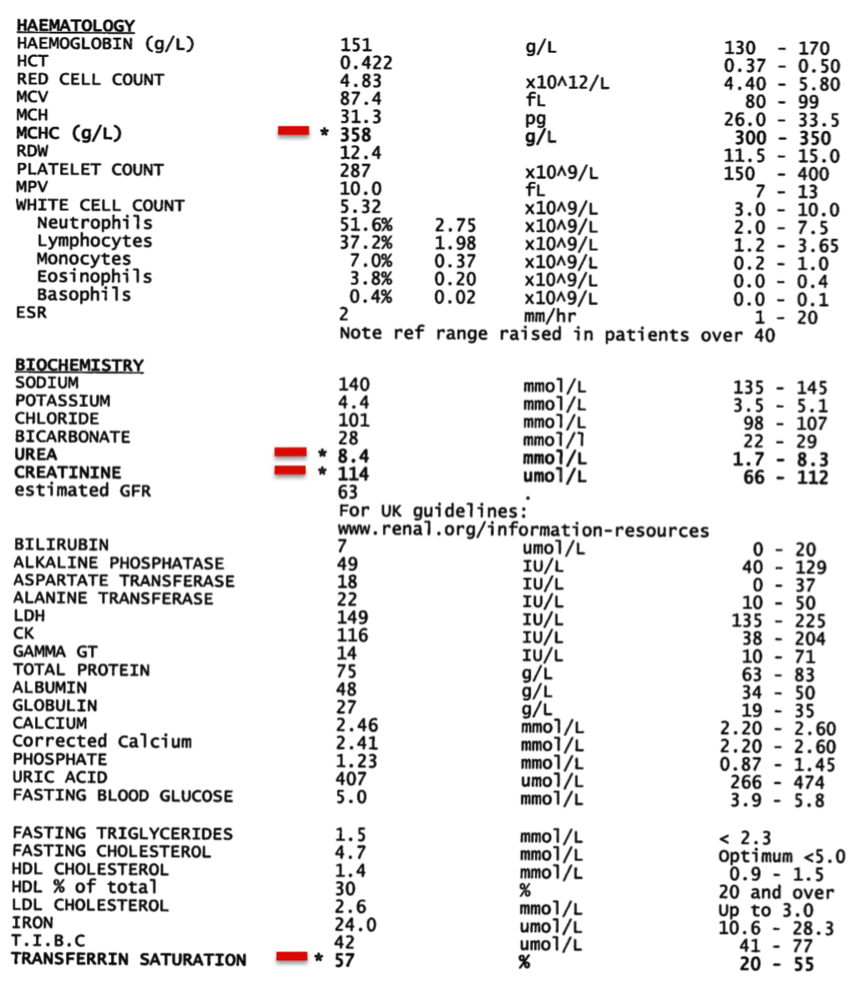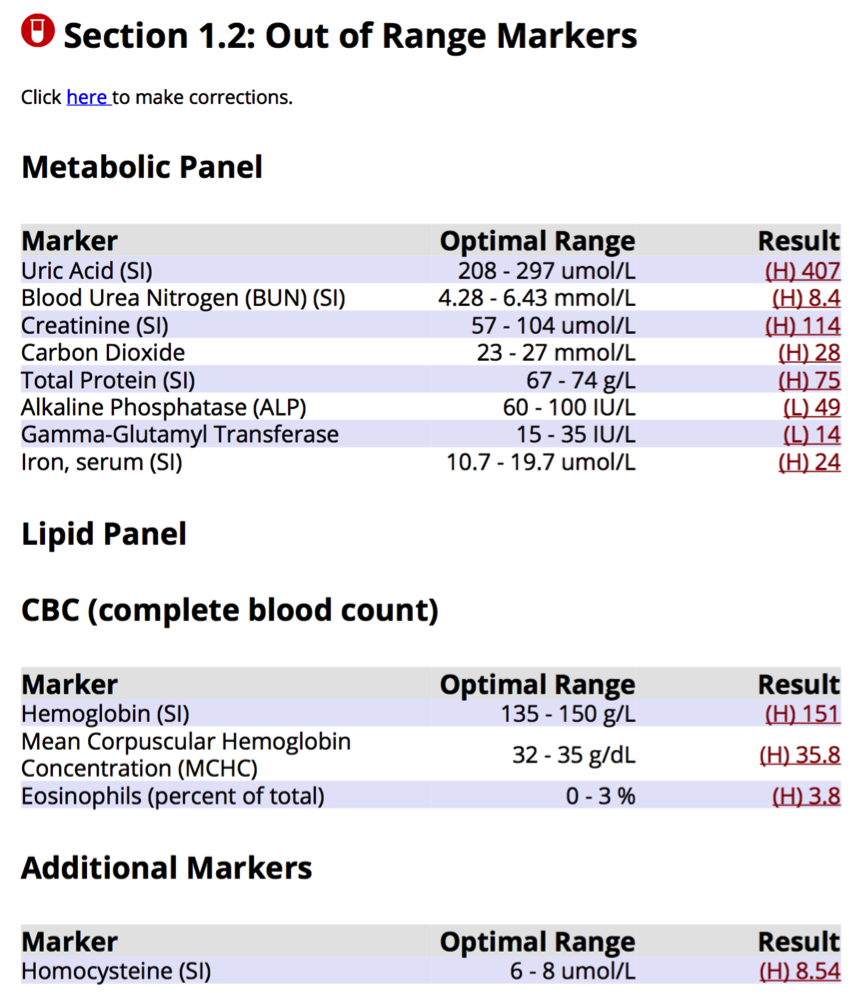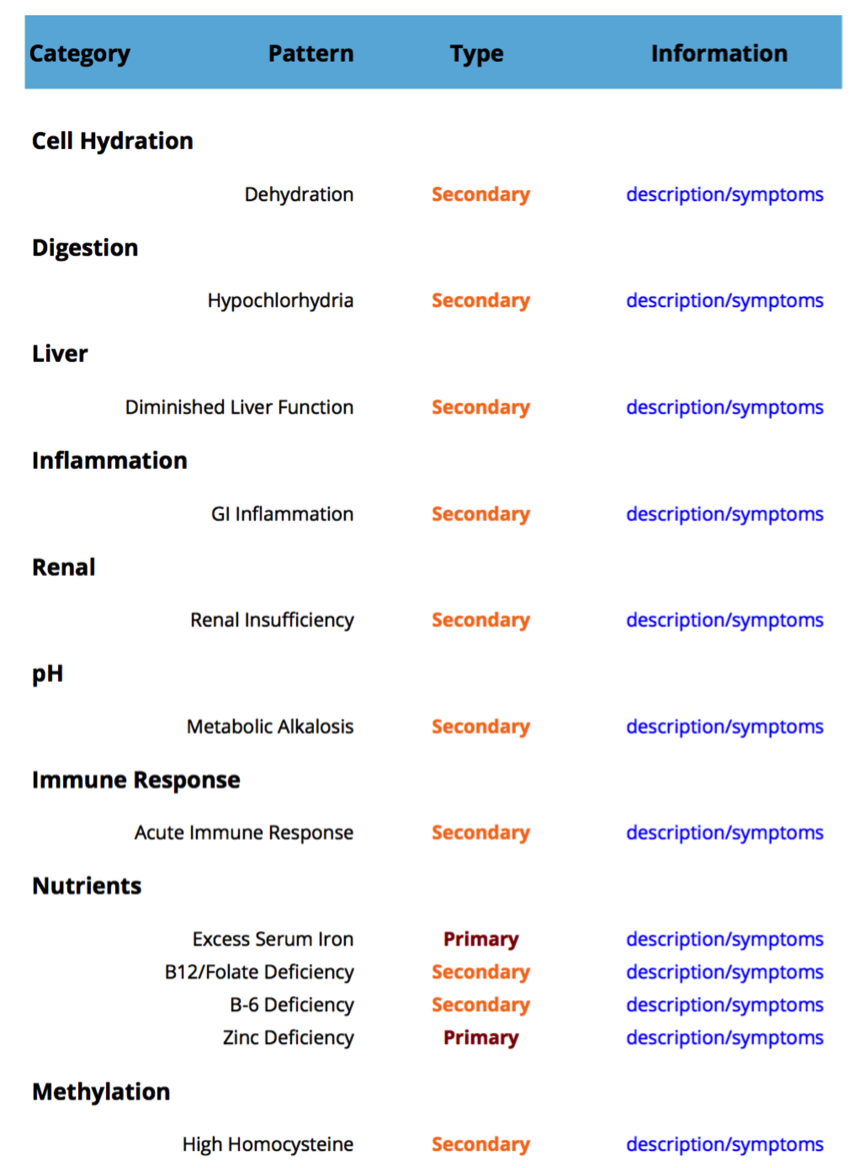THANK YOU for taking the time to read the previous three posts in this series.
It’s time to pull the information together using some examples and reveal how you can get your blood test assessed using functional ranges so it finally gives you some helpful information to work from!
Remember that we offer a customised blood testing service – complete with functional analysis – that we feel is superior to what you’ll receive from the medical system (details are included in this article).
Dave Hompes’ blood test result
Take a look at my blood test result, below.
The small asterisks show values that fall outside the medical ‘normal’ and I’ve highlighted them with red lines for ease of reading.

The four markers out of range are:
- Elevated MCHC = a marker telling us about the average amount of haemoglobin in blood cells; an elevation indicates possible anaemia (macrocytic).
- Elevated urea and creatinine, indicating some possible kidney dysfunction.
- Transferrin saturation is a marker showing how much iron carrier protein is currently available; when elevated, it shows I may be at risk of iron overload.
Looking deeper…
The reason I did this test (and others I’ll describe) is because I’ve noticed myself feeling a little tired of late, and my performance in the gym isn’t what I’d expect from myself.
I’ve also noticed a few other very mild symptoms, including dry skin on my face, slightly disturbed sleep and my finger and toenail quality has deteriorated slightly.
Added to this, I had a couple of days where I experienced palpitations, my blood pressure is a little higher than I’d like, and my waking temperature and pulse are lower than I’d like to see, indicating reduced energy production.
These symptoms probably wouldn’t bother most people, but I am very sensitive to changes in my body and so I’m checking everything out properly.
The functional blood chemistry analyser
I ran my data through a functional blood chemistry analysis software, which automatically narrows the reference ranges from pathological (conventional interpretation) to ideal/optimal (functional interpretation).
Here’s the outcome:

In the above graphic, you can see that fully 12 markers are outside the functional reference range, whereas only four markers fell outside the pathological reference range.
In other words, and in simple terms, my results have three times more meaning from a functional perspective, but I would never have known about these had I not used a more advanced analysis system.
The homocysteine marker, at the bottom of the the list, was not tested on my main blood test.
It’s a little high at 8.54 but I’ve seen people as low as 3.5 and as high as 16.5, values which represent potentially serious imbalances!
Homocysteine has to be tested separately and is rarely, if ever considered in the medical system here in the UK despite being an ultra-important marker for assessing cardiovascular disease risk.
So what?
So I know I have 12 (13 is we include homocysteine) markers out of balance if my test is considered from a functional perspective.
But what does that really mean?
Here’s where it gets interesting because these markers really do mean something.
When a blood test is interpreted functionally as opposed to pathologically, it tells us a great deal about hydration and nutrient status, digestive, liver and kidney function, immune function, infections and inflammation.
Below you can see the summary from my blood test report and you can see that there are some secondary and primary issues to deal with, or investigate further:

Without going into a huge amount of detail, I’m looking at this test tying everything together.
I can see there are indications of four nutrient deficiencies – B12, folate, B6 and zinc.
I can see that homocysteine is a little high, and I know that B12, folate, B6 and zinc are all needed to keep homocysteine in balance, so this adds up.
Going further back up the list, I can see that there is an indication of low stomach acid (hypochlorhydria).
Well, stomach acid is needed for B12, folate, B6 and zinc absorption.
Interestingly, B6 and zinc are needed for stomach acid production.
So again, this all adds up.
I can see there’s a little kidney and liver stress and, interestingly, some indications of dehydration despite drinking plenty of water.
Finally, my serum iron levels are high, which is interesting because if I also look at the original test, I can see that my transferrin saturation is high and my total iron binding capacity (TIBC) is low.
All three of these markers suggest iron overload, which is a potentially serious condition that I need to investigate further to loo for a genetic disease called haemochromatosis.
Ultimately, haemachromatosis can lead to serious arthritic pains, which actually run in my Mum’s side of the family, liver and kidney disease and an early death.
Can you see how a simple blood chemistry analysis, when interpreted with a little more care, can help us head of disease at the pass?
I could go on, but this article will be too long if I do.
Blood chemistry is incredibly revealing and massively helpful
I chose to do a blood test and some other panels because I was just feeling a little low on energy and a little sluggish by my standards.
The test revealed dysfunction in certain areas even though I don’t have symptoms (for example, GI inflammation along with liver and kidney stress).
It also revealed nutritional deficiencies that need to be addressed if I’m looking for 100% optimal health, which I am because I have big goals in life and achieving them requires a lot of energy.
So even though I feel okay by most people’s standards, there are still areas for improvement and I may have uncovered the early stages of an inherited iron overload disease.
Action steps guaranteed to of benefit based on blood chemistry data
Within an hour of receiving these test results, I began taking action:
- Betaine hydrochloride capsules with meals to support stomach acid
- Zinc, 50-75mg/day to support this important mineral
- B6 (in the P5P form) 50-100mg/day
- Reduced iron intake through altered diet
- B12 and folate supplementation (introduce after one week)
- Focus on consuming water-dense vegetables and fruit to improve hydration
- Check urine pH daily using home pH strips
How to get a customised functional blood chemistry analysis
If you’re tired of being told your blood tests are all ‘normal’, perhaps we can help.
Your usually dull and uninspiring blood test results can be brought to life with a functional blood chemistry analysis, and it will, without question give you some major clues as to why you’re not feeling at your best.
Our functional blood chemistry analysis service includes a detailed case history, food diary review and 60min consultation in addition to assessment of your blood chemistry.
It will also provide information that you can take action on immediately, whether it’s dietary changes, digestive, liver or kidney support, or nutritional supplements.
You’ll also get a clear picture of which other tests will add helpful information and help you deeply investigate the root causes of your symptoms.
There are two you can take advantage of this service.
Option #1 – you already have some solid blood test data and don’t need a customised test with one of our partner labs
You can send us your previous blood test results, as long as they are from the last three months.
If your blood test was reasonably comprehensive, we can run your data and consult with you on the findings, within the context of your symptoms, health history and lifestyle.
If you had ‘half a test’ in which important markers were omitted, we can still run your data, but it won’t be as meaningful.
If you’re not sure whether your test was truly comprehensive, feel free to email it to us and we’ll provide some feedback for you.
Option #2 – you don’t have blood test data and would like to get a customised blood test from one of our partner labs
We’ve set up partnerships with specialised medical labs in the U.K. and U.S. that you can use to obtain a truly comprehensive blood test.
If you’re having trouble getting your doctor to run a really comprehensive test, we can help.
You can then take the results to your doctor to check as well as having your data run through our functional analysis system.
We offer three levels of testing – “Comprehensive”, “Comp Plus” and “Deluxe”.
Click here to learn more about these blood tests, how you can get one and how the process works.
Best,
Dave.

Comments are closed.